Sage Thrasher spring activities have been ramping up for weeks and I’ve been lucky enough to photograph a variety of them.
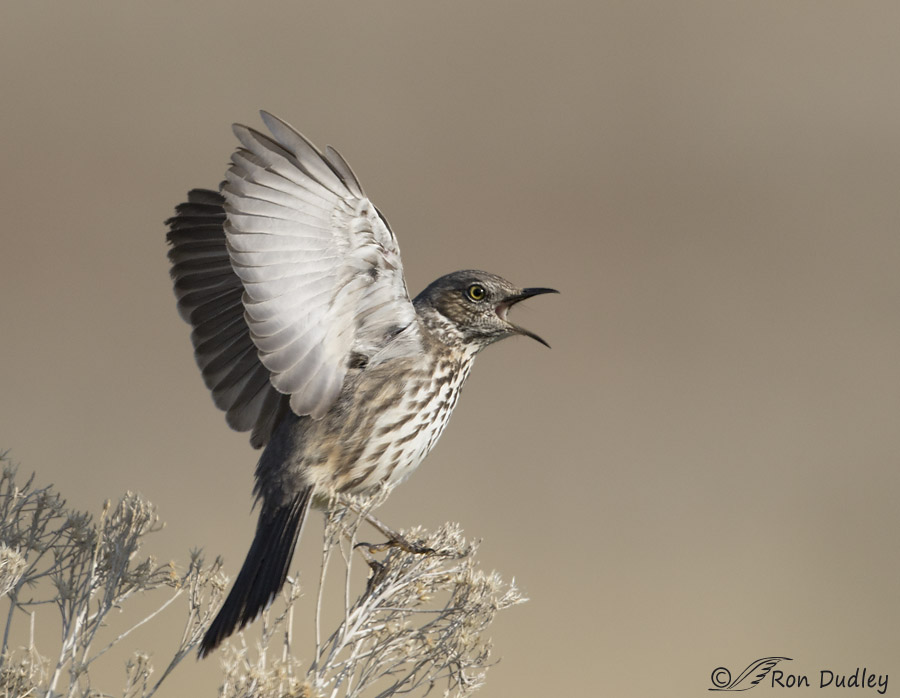
1/2500, f/6.3, ISO 500, Canon 7D Mark II, Canon EF500mm f/4L IS II USM +1.4 tc, not baited, set up or called in
I photographed this Bilateral Wing Display four days ago on Antelope Island. It’s part of their courtship display and I’ve invested a lot of effort in photographing it with limited success, partly because (according to Birds of North America Online) it’s “only rarely seen”. During the display the thrasher raises and flutters its wings for several seconds while continuing to sing. The behavior is thought to be part of courtship and to function as a threat to other thrashers. This bird allowed me the closest look and the best light (both marginal) I’ve been able to get so far.
But as of yesterday (when each of the following photos was taken) I believe thrasher courtship displays may be largely over for the season, partly because many thrashers are already feeding young in the nest.
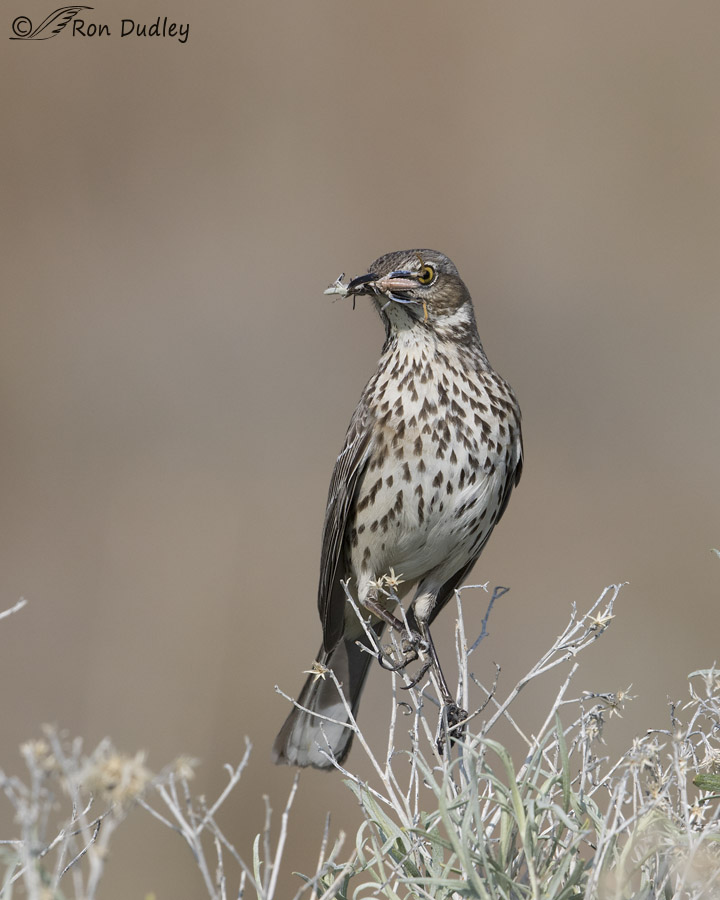
1/3200, f/7.1, ISO 500, Canon 7D Mark II, Canon EF500mm f/4L IS II USM, not baited, set up or called in
The thrashers were obviously feeding their hungry chicks because they repeatedly landed on top of the sage and rabbitbrush with food and then dived down into the bushes with it. The preferred fare was grasshoppers and this one has two of them in its beak.
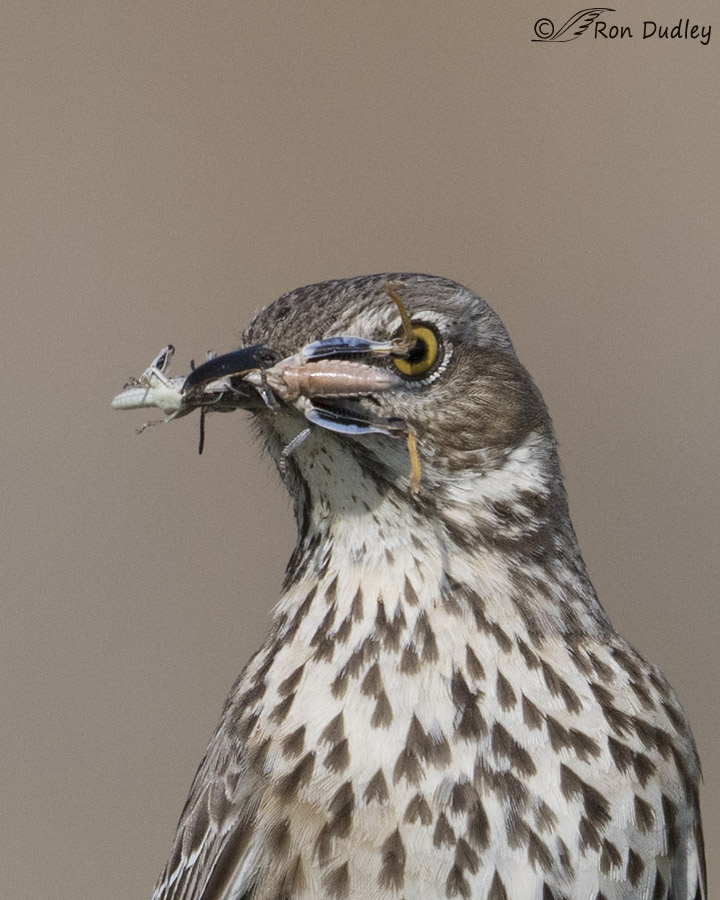
1/3200, f/7.1, ISO 500, Canon 7D Mark II, Canon EF500mm f/4L IS II USM, not baited, set up or called in
The curious biologist in me can’t resist a closer look at their diet so I cropped the image close for more detail. The grasshoppers appear to be of different species and the one on the right is quite colorful for my area (based on my anecdotal observations).
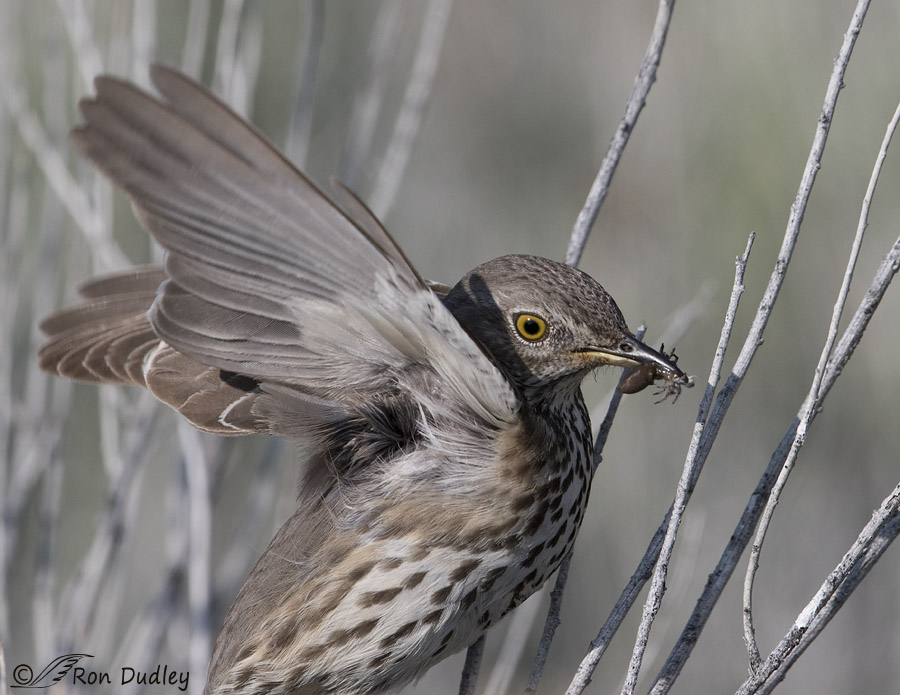
1/3200, f/8, ISO 500, Canon 7D Mark II, Canon EF500mm f/4L IS II USM +1.4 tc, not baited, set up or called in
This thrasher landed close to me and when it took off it made a twisting turn to avoid the twigs which gave me a fairly good look at its prey, perhaps a spider. Or two.
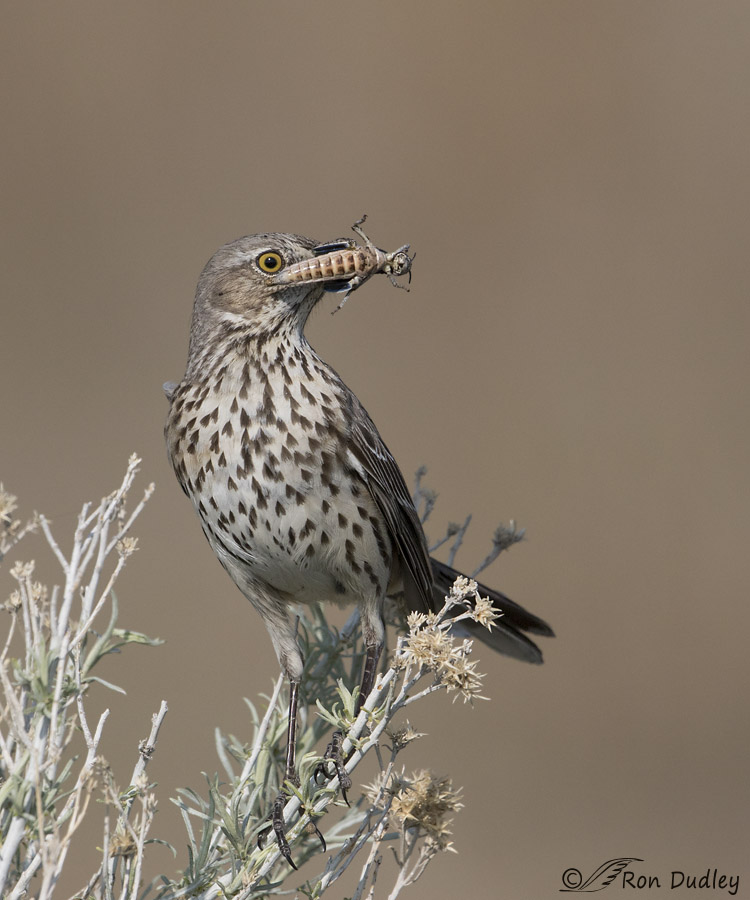
1/3200, f/8, ISO 500, Canon 7D Mark II, Canon EF500mm f/4L IS II USM +1.4 tc, not baited, set up or called in
I was slightly surprised to see grasshoppers this large so early in the season. Just three days ago I saw thousands of newly hatched grasshoppers fleeing from hungry birds but they were only about the size of a grain of rice. I imagine different species mature at different times.
Young Sage Thrashers begin to leave the nest at the ripe old age of 9 days and typically there are 4-5 eggs in a clutch so I have hopes of photographing parents feeding fledglings on top of the sagebrush soon.
Time will tell if I’m successful.
Ron
Note: In the past some readers have been a bit taken aback when I’ve referred to the insect food of songbirds as “prey”. Webster defines prey as ” an animal that is hunted or killed by another animal for food”. Both insects and birds are animals so for me it’s an appropriate term for the situation and I continue to use it in this context.


Breathtaking shots Ron! Thanks for sharing!
Charlotte
Great shots. Even if that first one isn’t perfect, it definitely and clearly shows the behavior.
As for grasshoppers, they do hatch and mature at different times of year. Here, the Horse Lubber grasshoppers don’t appear until September. Right now we just have one or two species out that I have observed. Also, sometimes the coloration on a grasshopper depends on the amount of rain. The most vivid example I’ve ever seen is Plains Lubbers in late summer 2008, when there had been lots of rain. They were bright pastel shades of pink, blue, yellow and green. Other years they are pale or brownish, and it’s hard to realize that they are the same grasshopper, since their coloration can vary greatly from year to year. Most of the grasshoppers I’ve encountered don’t have the variable coloration.
Interesting points you make about grasshoppers, Susan.
My primary experience with grasshoppers (besides dissecting them for so many years) was in northern Montana where the most common species didn’t become large until late August/September – just in time for harvest. When our wheat and barley came out of the combine it was full of grasshopper parts and when I was driving grain truck with the window open and one of those suckers hit me in the head it would almost knock me out. I think my first cuss words as a kid were directed at grasshoppers…
“Thrasher”/”Thrush”–that makes sense. Glad Mia remembers those HUGE grasshoppers…they’re not only BIG but also beautiful….I wonder if they’re found anywhere else. Your reply to Jo Anne Donnelly expresses why your blog means so much to me….sadly, I share the same concerns and feelings….you allow me to “take flight”, temporarily, from these depressing realities…
Patty, I just looked up Florida grasshoppers, choosing a particular kind on a hunch, based on your description. It sounds like an Eastern Lubber grasshopper. All of the Lubbers are large grasshoppers. Here in the El Paso area we have Horse Lubber grasshoppers, which are black, with yellow lines and red underwings. Nearby in New Mexico we’ve seen Plains Lubber grasshoppers, which can be all sorts of colors, including some pretty pastels. The range of yours goes across the south thru the eastern part of Texas, and includes Georgia, South Carolina and a small part of North Carolina. Here’s a link to the page I was looking at: http://entnemdept.ufl.edu/creatures/orn/lubber.htm
Mia says she has photos of those Florida grasshoppers somewhere and that they were Lubbers.
I was taken aback by “prey” but adjusted my own thinking on that word. 😀 Nicely educated, Mr. Dudley!
“Nicely educated, Mr. Dudley!”
Loved your response, Arwen. Made my day!
Congrats on another goal, Ron!! I love following you on your photographic hunts & celebrate with you when a goal is met!! I love all of the photos you captured of the Thrasher. To see how clear & sharp they are makes me envious of your skill. I look forward every morning to the photos & stories you share – makes my day!! With what is happening in our human world, your photos of the wild birds around you brings me a lot of joy.
“With what is happening in our human world, your photos of the wild birds around you brings me a lot of joy.”
They do the same for me, Jo Ann, as does time spent in the field taking the images. It allows me to temporarily escape the depressing reality of what we are doing to our planet and its occupants, human and otherwise.
This has been a wonderful series…I especially like the close ups…with the sharp detail of bird and prey. I’m intrigued by the bird’s name. Every time I see a shot of a Thrasher with its open beak, I think of Catbirds and Mockingbirds. I wonder if Mia remembets seeing the huge black, yellow orange grasshoppers we had on Florida. My monkey loved them…
Yes, she remembers them, Patty. I just asked her about them.
Apparently the name “thrasher” is derived from the word thrush.
Ron, what a great photo of the bilateral wing display. And you are probably correct, it will take a lot of prey to feed the hungry nestlings. Thanks.
Diana, that display is difficult to photograph for three reasons: they are reluctant to do it when there’s a vehicle nearby, they nearly always face away from the sun during the display (don’t know why…) and it’s “rarely seen” in the first place. Given all that I was happy to get the shot. Thank you.